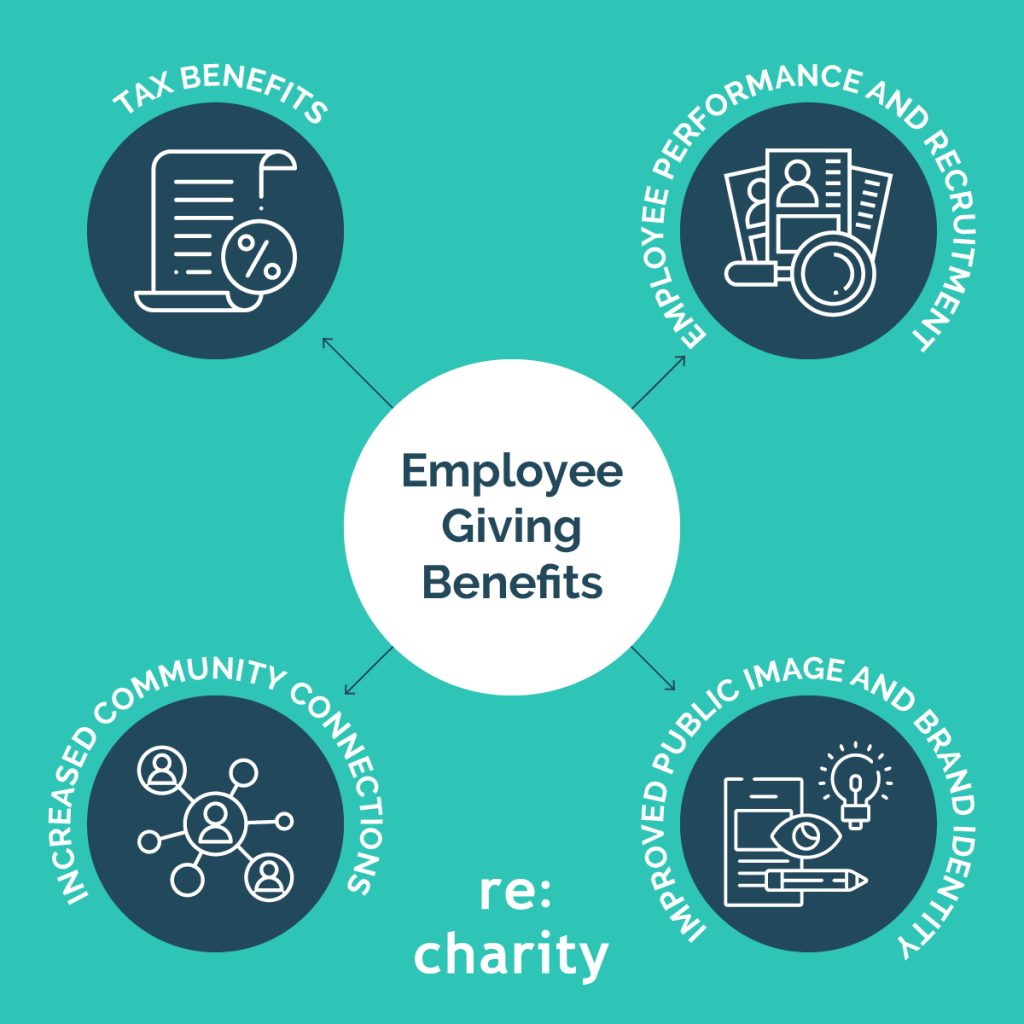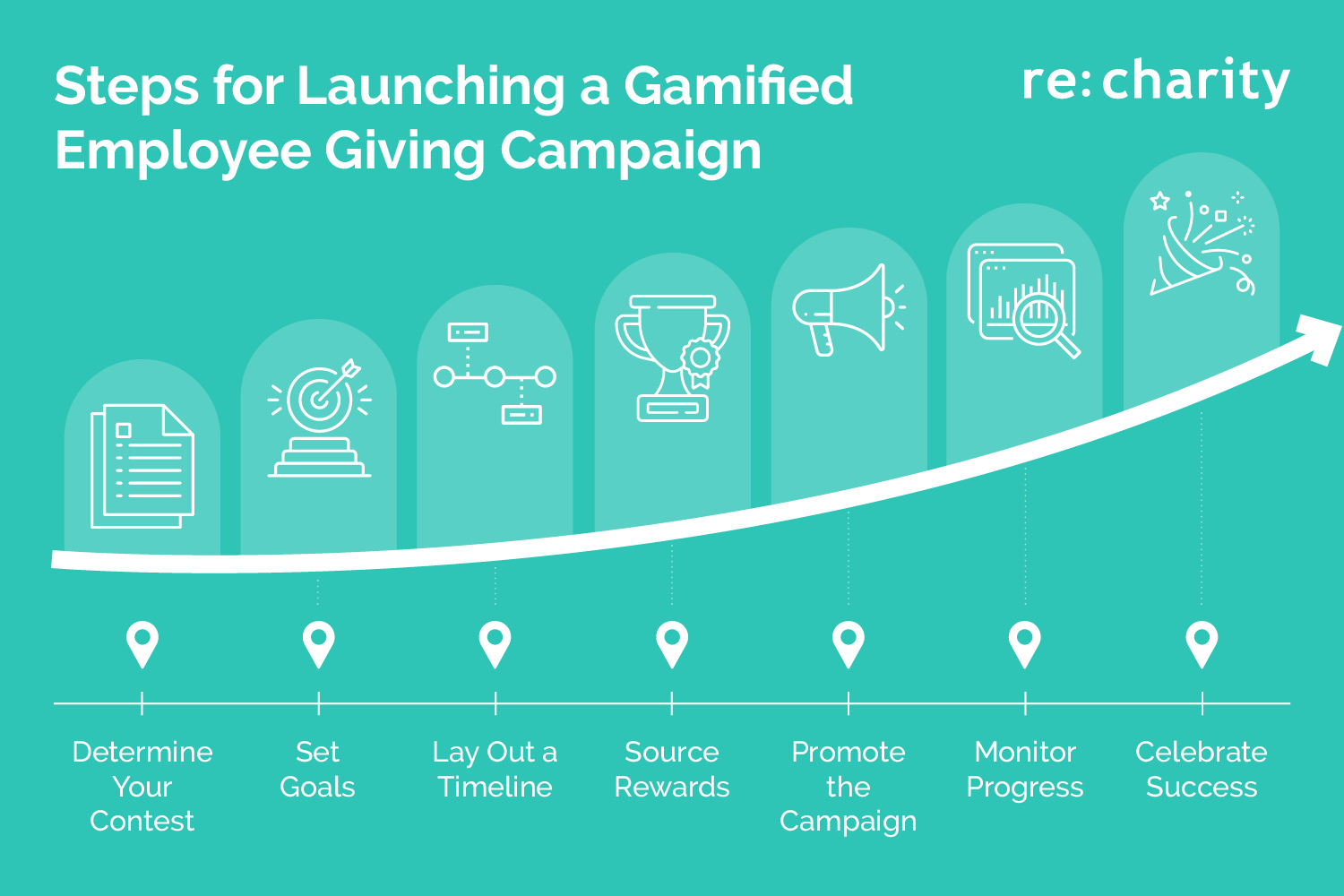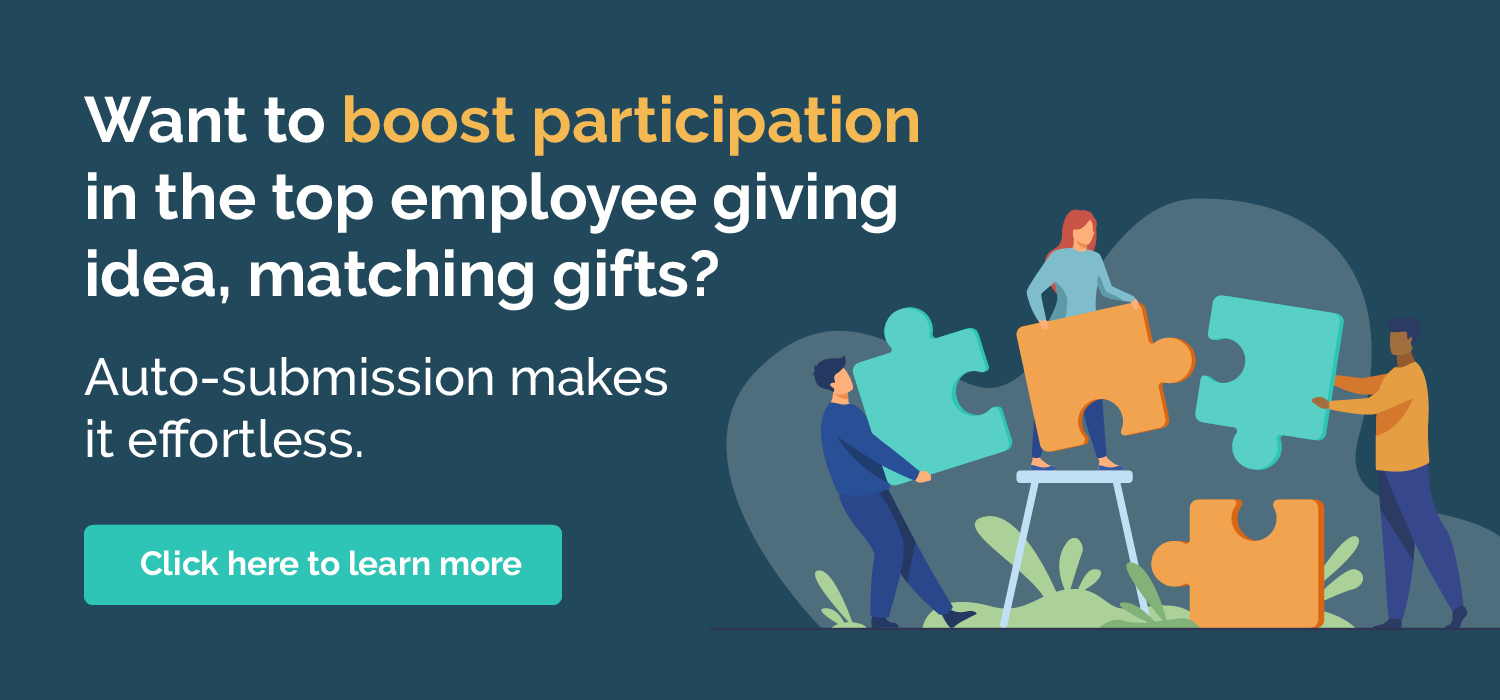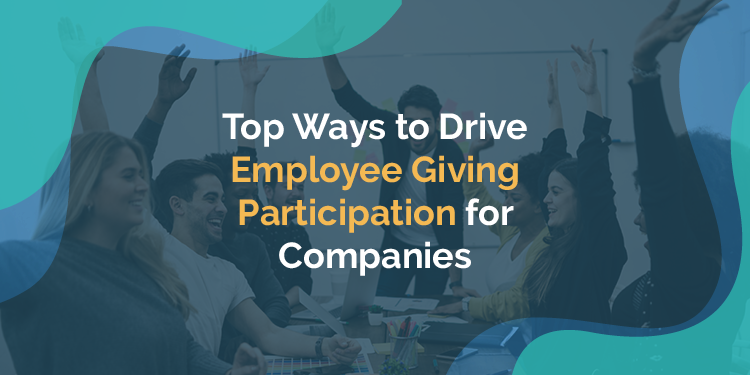
More than $4-7 billion in corporate matching gift revenue goes unclaimed by eligible nonprofits and donors each year. This is mostly due to a widespread lack of knowledge about available employee giving programs.
While many nonprofits are doing what they can to boost awareness of corporate giving programs, your company can take key steps to inform your employees of philanthropic opportunities and encourage them to make a difference in the community.
If your business is looking to increase its corporate social responsibility efforts and elevate employee engagement, this guide will walk you through five impactful steps to take. We recommend that you:
- Set broad employee giving participation guidelines.
- Simplify the employee giving process.
- Allow employees to submit matches directly where they give.
- Emphasize mission impact to employees.
- Leverage gamification techniques.
When you implement these practices into your company’s workplace giving strategy, more employees will be eager to take part than ever before. But first, let’s review why employee giving is so crucial to your long-term success.
Why is employee giving important?
For company executives, it might not be immediately obvious how corporate giving initiatives can advance their interests. Consider the following benefits that can accompany robust employee giving initiatives:
- Boosted employee performance and recruitment. When companies support their employees’ philanthropic passions, it helps cultivate a healthy and fulfilling work environment, which catalyzes innovation. Plus, it’s a nice perk to attract talented applicants to your company.
- Improved public image and brand loyalty. With 77% of consumers being motivated to support socially responsible companies, prioritizing employee giving provides your company with a competitive advantage.
- Increased community connections. Your company’s activities impact your community in many ways, so taking the time to give back shows that you’re committed to its health and growth. This could also provide the introductions needed for you to take on other facets of corporate social responsibility, such as sponsoring nonprofits.
- Tax benefits. Depending on your city and state tax codes, it’s possible that your company can write off some contributions from employee giving programs from your taxes.
Empowering employees to make a difference in their favorite causes can improve your community and make your team more cohesive, skilled, and motivated.
Now that you understand how employee giving can transform your company, you might be wondering how to get your team on board. Let’s dive into our top five tactics for encouraging employee giving.
5 Ways to Drive Employee Giving Participation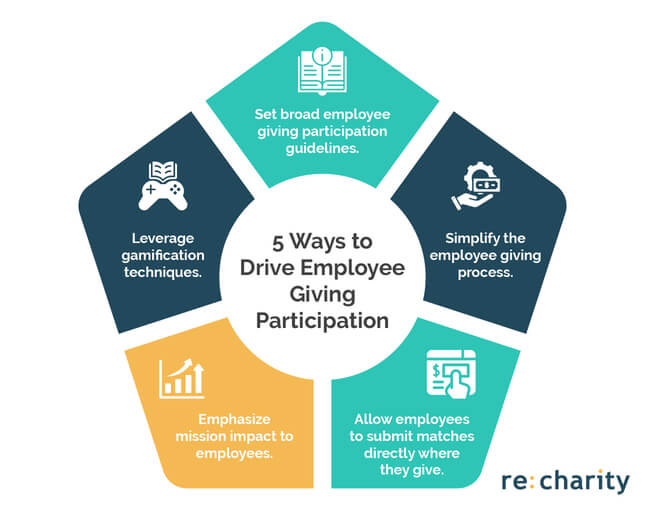
1. Set broad employee giving participation guidelines.
To increase employee giving participation, start by taking a look at your program guidelines.
Let’s explore a few aspects of your giving programs to consider adjusting to drive participation:
- Employee eligibility: Each company that organizes a workplace giving campaign must determine which types of employees are eligible to participate. More than likely, all full-time employees will qualify—but you can choose to include part-time staff, retired workers, and employees’ spouses as well! By opening up your employee giving program, you’ll be sure to see increased levels of participation.
- Qualifying types of nonprofits: While some companies fund nonprofits with a particular type of cause or mission, others consider any registered 501(c)(3) organization as eligible. Companies may also exclude certain types of nonprofits (such as houses of worship and other religious organizations). The more nonprofits that fall eligible for your employee giving, the more likely your employees will find charities that align with their personal values and inspire their support.
- Minimums and maximum gifts: Consider keeping your minimums low and your maximums high. After all, not every employee has the ability or desire to make a major donation to a nonprofit. If your minimum threshold is too high, fewer individuals are likely to participate. At the same time, maximums that are too low can cause employee donors to question whether their participation is all that impactful in the first place.
- Submission request deadlines: Your employees are busy people. If you set giving deadlines that arrive too quickly, many potential participants will not get around to taking the required action until it’s too late. When you give your staff ample time to prepare submit their workplace giving requests, you allow more individuals to get involved—thus elevating your employee giving levels.
If your criteria for participation are too strict or narrow, they’re likely causing a significant barrier to entry. And that’s exactly what you don’t want when it comes to increasing employee engagement with your giving programs!
2. Simplify the employee giving process.
The easier it is for someone to support a cause, the more likely they are to participate. This is true whether you’re on the nonprofit end running a fundraising campaign or an employer organizing a workplace giving initiative.
Since providing an optimal giving experience leads to an increased ability to do good, consider taking these steps to simplify giving for your employees:
Effectively communicate program participation criteria
Once you’ve solidified your program participation guidelines, it’s important to clearly communicate them to your employees—otherwise, they’ll never know how easy it is to get involved. You’ll also want to promote employee giving participation in several programs by highlighting your corporate giving opportunities at multiple internal touchpoints.
Offer many easy ways to give
There are numerous ways to support a nonprofit cause. For instance, an employee may give directly to the organization through its website, donate via a peer-to-peer fundraiser, send a check in the mail, contribute through a third-party workplace giving platform, and more.
Studies show that the vast majority (more than 96%) of donors prefer their employer’s giving programs to encompass support through all of these avenues rather than narrowing the options to a single giving channel.
There are also other forms of corporate philanthropy your company can offer beyond typical donation and matching gift opportunities. Consider implementing the following initiatives to increase employee engagement:
- Volunteer grants. Like matching gifts, volunteer grants provide monetary support for nonprofits where employees regularly volunteer. However, instead of matching employee donations, companies that offer volunteer grants contribute a certain amount of money per hour their employees volunteer with an organization. For example, a company may donate $25 per hour an employee volunteers.
- In-kind donations. Nonprofits need more than just financial gifts. Many of them benefit from in-kind donations of goods and services. For instance, an animal shelter will likely accept donations of leashes and pet food. Businesses can organize in-kind donation drives and encourage their employees to drop off items for their nonprofit partners.
- Pro bono work. It can be difficult for charitable organizations to find affordable business expertise. Companies can provide pro bono services to nonprofits in need so these organizations can reserve their funds for mission-critical projects. Corporate employees may assist nonprofits in legal consulting, financial management, marketing and graphic design consulting, event planning, and website development.
When you offer a variety of ways for employees to get involved in corporate philanthropy—especially options that don’t require monetary donations—you can increase engagement in your employee giving initiatives and provide more support to nonprofits in need.
Engage employees with custom matching gift initiatives
Some employees may be looking for a way to give back to charitable causes without having a specific organization in mind. In that case, researching and choosing a nonprofit to support can become significant roadblocks.
But with a custom matching gift program (which may also be referred to as a “one-off” or “unique” program), your company can select a particular organization that reflects your own values well to benefit from your employee giving opportunity. From there, you’ll rally all team members around the cause and encourage staff to give, then match the employee donation total at the conclusion of the campaign.
Ensure a streamlined request process
The more steps involved in your workplace giving request and submission processes, the less likely each employee is to follow through from start to finish.
Fortunately, one of the best ways to streamline these processes is by working with a dedicated employee giving software provider that offers a user-friendly employee experience. Some of these providers even offer matching gift auto-submission, which allows donors to request their corporate matches in a single click directly from the gift confirmation page. To easily identify top matching gift platforms, look for a CSR vendor with the CLMA designation (Certified Leader in Matching Automation). These auto-submission-enabled platforms offer the best experience for your employees, meaning higher rates of engagement overall!
Automatically deduct donations from paychecks
Between your employees’ work schedules and personal lives, it’s easy to see how donating might fall by the wayside. However, you can provide your employees with peace of mind by doing the work for them with payroll deductions.
By deducting donations from employee paychecks, you guarantee participation from even your busiest team members. All you need to do is ask employees to opt in and designate the amount they’d like to contribute each pay period. Your employees will appreciate being able to make an impact without lifting a finger!
3. Allow employees to submit matches directly where they give.
Although some corporate giving vendors require giving to be processed through their own software systems and passed along to the nonprofit to qualify for workplace giving opportunities, studies show that donors would rather contribute directly to the organizations they support.
In fact, an estimated 86% of donors reported a preference for contributing to a nonprofit through their website, while 8% of survey respondents “indicated a preference for P2P, direct mail, or another form of [direct] giving.” On the other hand, only 6% of donors stated a preference for giving through a workplace giving software provider.
When it comes to nonprofit giving, donors want to give in a way that feels most personal to them—and that means straight to the organization with as few roadblocks as possible. And the same is true for submitting their workplace giving (i.e., matching gift) requests!
If an individual could complete their end of the matching process without having to leave the organization’s website, it would reduce and eliminate a significant number of matching gift roadblocks.
In the end, that means more corporate giving revenue for nonprofit organizations, additional engagement opportunities for donors, and elevated program participation (and satisfaction) for companies and corporate software vendors.
The easiest way to do so? Utilizing matching gift auto-submission!
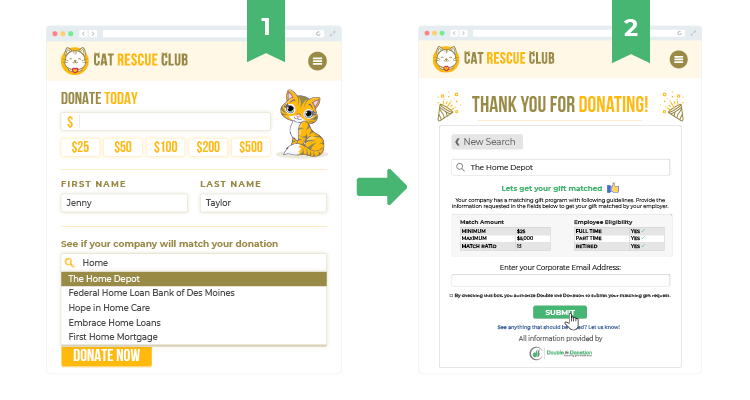
With this new workplace giving software functionality, employees can submit their matching gift requests in just a few clicks directly where they gave to the organization. And more than 75% of the largest peer-to-peer focused nonprofits are already eligible to receive automatically processed match requests—just by being equipped with Double the Donation’s tools!
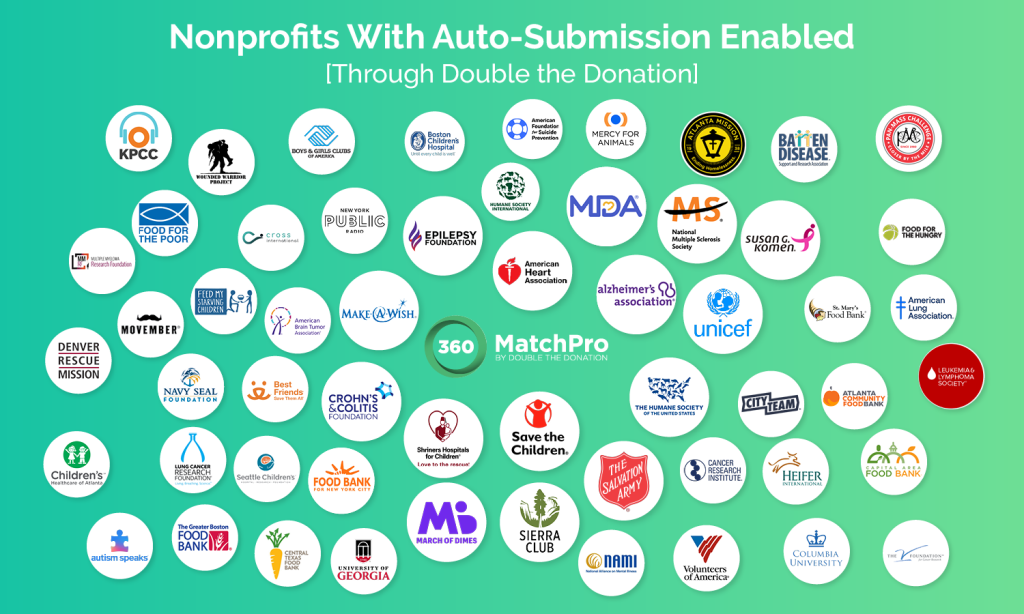
4. Emphasize mission impact to employees.
According to workplace giving research, approximately 81% of employee donors cite a nonprofit’s mission as one of the most important factors going into their decision to support a fundraiser. As such, communicating the effect that your company’s giving programs have on charitable organizations (and the causes behind them) is essential.
You can highlight the impact of employee giving participation and encourage more involvement by:
- Sharing employee giving success stories. It can be extremely impactful to provide employees with positive examples that inspire them to take part in your charitable and philanthropic initiatives. For example, you can share facts and figures such as, “We raised $12,000 to feed over 2,400 families in our community,” or “Your employee giving dollars provided 1,780 students with much-needed school supplies to support their education.”
- Offering a high match ratio. The higher your company’s matching gift ratio, the more impact employees can generate with their dollars. If you offer a 3:1 ratio, for instance, you can emphasize to employees that their impact will be tripled—enabling an initial $50 gift to create $200 worth of mission value. This can be a significant contributing factor, since an employee may not be as motivated to turn their $50 gift into $75 with a .5:1 ratio.
- Recognizing employees for participating. Create a culture of generosity and recognition within your company by acknowledging employees for giving back to the community. According to eCardWidget, you can create employee recognition eCards as a quick and convenient way to recognize employees who embody your company values and participate in your corporate philanthropy efforts.
Ideas like these can show employees that their participation in corporate giving programs can make a real difference—especially on causes that they care about.
Another way to drive employee giving participation is by leveraging a fundraising thermometer. While this tactic takes a more abstract approach to visualizing giving impact (rather than a concrete, mission-focused perspective), a continually updated fundraising tracker can allow employees to watch as their contributions help increase total giving toward a common goal.
5. Leverage gamification techniques.
Who doesn’t love a little friendly competition and winning a prize, especially when it’s for a great cause? Introducing gamified elements to your employee giving campaigns can elevate participation and camaraderie amongst your team members.
However, starting an employee giving challenge requires more forethought than simply setting a deadline and a random fundraising goal. Consider the following steps to get your efforts up and running:
- Determine what type of contest you want to run. Between one-off challenges, ongoing rewards systems, and more, you have many options for the type of employee giving contest you run. Pick based on the campaign’s theme, your employees’ interests, and your company’s niche. For instance, a sports apparel company might choose to host a company golf tournament because of its industry relevance.
- Set fundraising and participation goals. Your contest’s objectives must be carefully selected to ensure that the campaign is feasible and enjoyable for employees to participate in. Your goals should follow the SMART framework (specific, measurable, achievable, relevant, and time-bound). Also, keep in mind that it isn’t just fundraising progress that you should monitor—understanding campaign participation metrics can help you optimize future employee giving efforts.
- Lay out a timeline for the contest. Though you should set overarching start and end dates in your initial planning phase, you should outline the different milestones for your challenge before you release information to employees. For instance, you can highlight when each employee’s progress will be checked and other minor milestones that occur before the campaign’s conclusion.
- Source the rewards. Though simply contributing to a great cause is reason enough to join an employee giving campaign, you can sweeten the pot by adding rewards for the top performers. Based on your budget, pick rewards that coincide with the challenge’s theme without breaking the bank. Continuing with the sports apparel company example, running a corporate golf tournament might reward the top three earners with memberships to top golf destinations and the fourth through tenth-place earners with a nice golf shirt.
- Promote the challenge. Many employee giving contests have the potential to succeed, yet underperform due to insufficient outreach from the company. Ensure your initial company-wide announcements occur via visible channels, such as an All-Hands meeting, so the word gets out to everyone. Then, remind the company at various intervals to join the fun. Add urgency to your messages so employees feel inspired to either sign up or ramp up their fundraising efforts.
- Monitor campaign progress in real time. As mentioned earlier, using digital fundraising thermometers helps participants visualize the campaign’s progress and what still needs to be done. Besides that resource, send regular updates to the company detailing how much space is between employees and the finish line.
- Celebrate the winners’ success. Now for the fun part! Thank all of your participants for playing and reward your top performers with prizes.
Remember that every employee giving campaign should be a learning experience. As you run your first challenge or change your approach from before, monitor key performance indicators, such as participation and rate of donation growth, to pinpoint what’s working and what should be improved for next time.
When you leverage these powerful best practices for your company’s giving initiatives, you’ll benefit not only your own bottom line but also your employees’ satisfaction, engagement, and retention. Additionally, you’ll play a significant role in helping nonprofits make the world a better place. Best of luck and happy giving!
To learn more about employee giving and how your business can drive participation, check out these other educational resources from thought leaders in the CSR space:
- Announcing New Matching Gift Auto-Submission Functionality. One of the best ways to drive employee participation in your company’s giving programs is by significantly simplifying involvement. And matching gift auto-submission can help you do so with ease!
- Employee Matching Gift Examples. This guide from Selflessly shares multiple excellent examples of companies that are doing matching gifts right. Find out what you can learn from these experts to boost your own employee giving participation!
- How to Offer the Ultimate Employee Giving Experience. Check out this research-backed resource by Double the Donation that provides tried-and-true tips for strengthening workplace giving initiatives. Explore the guide to see what you can do better.
- Why Workplace Giving Matters for Nonprofits + Companies. Workplace giving is a win-win situation for nonprofits and companies alike. Browse the key benefits for each party and what you can do to maximize these advantages for your business.

